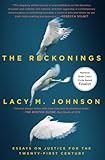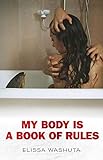Randon Billings Noble values form as much as content. Her new book of essays, Be with Me Always, is a collection about heartbreak and memory, and, in her words “hauntedness.” Consider an essay called “Vertebrae,” which is shaped like a spine, and another, “The Heart Is a Torn Muscle,” written as a cardiologist’s report. Noble does wonderful things with form; she is a beautiful writer, fully in control of her craft. Her essays cover a wide range of subjects—a near death experience, a relationship read through the catastrophic romance of Henry VIII and Anne Boleyn, Stonewall Jackson’s amputated arm, pregnancy, reunions, and silences. Her words are lyrical and, yes, haunting. Among the many pleasures of this collection is Noble’s take on situations that look ordinary to an outsider, but, for the individual experiencing them, are life changing. Noble is not scaling Mount Everest or courting self-destruction; she’s living a life that is as recognizable as it is engaging. And that, perhaps, is the book’s greatest allure: an intimacy that is both welcoming and enveloping.
I had the good fortune to catch up with Noble by email to talk about her process, the impact of form on her writing, her influences, and more.
The Millions: Readers are always interested in process. As we get to know you, can you talk about your writing trajectory?
Randon Billings Noble: I’d always been interested in essays and found myself looking for subversive ways to liven up college research papers. But I didn’t really know that essays could be their own thing until graduate school, and not through the classes I was taking, but the classes I was teaching while getting my MFA at NYU.
NYU taught expository writing (aka freshman comp) in a way that valued personal experience as a form of evidence. You could do research at the library, or interview subjects, or crunch numbers, but you could also use something that happened to you as a child, or an odd experience you had on the subway, or a conversation you had with your best friend to support and explore your thinking. Finally! A name for that thing I’d been doing my whole writing life; I was an essayist.
TM: Many writers have a difficult path to publication. Can you talk about yours?
RBN: With individual essays, getting published was fairly smooth. So I wasn’t prepared for the challenges of publishing a book, which was more like playing “Chutes and Ladders.” My third published essay was in the Modern Love column of The New York Times. A fancy New York agent wined and dined me so I could be her literary passion project. Over lunch at Nobu, we had what I thought was a very frank conversation about who I was (an essayist) and what I wrote (essays). I was over the moon when she signed me! I felt propelled up that one big ladder that launches you. But then came the revision requests. She didn’t want an essay collection; she wanted a memoir. I tried to rearrange the essays more chronologically—but ultimately I couldn’t —wouldn’t—tear out the structures of my individual essays to make a full-length memoir. So my agent and I broke up. Then I was down the long chute that dumps you back to the start of the game.
At the time I was heartbroken. But it turned out to be a very, very good thing. I kept writing essays. I grew as a writer. I reshaped my collection. All the shorter chutes and ladders, the successes and rejections, made Be with Me Always a better book. I submitted it to independent and university presses and was thrilled when the University of Nebraska Press accepted it.
TM: The essay is an art form, and you’re very interested in form. What kind of impact does form have on your book?
RBN: I love traditional essays—if there is such a thing—essays that use narrative, that bring the reader along a consistent if sometimes meandering train of thought. I started writing in different forms without realizing this was a practice. My essay “Ambush,” published under the title “War Weary from a Dangerous Liaison” in Modern Love, started out as a segmented essay. It’s about letting the love of my young life go by telling him that I had married someone else, which felt like an ambush. Each short segment was introduced by a quote from the Army Ranger’s handbook with information about how to construct an ambush—or a counter-ambush. Late in the drafting process I took all the quotes out and the sections fell together perfectly. I didn’t need the trellis or scaffolding anymore.
Later, after my twins were born and my time became extremely limited, I started writing in shorter forms. Then I started to play more intentionally with lyric essays—essays that rely on intuition more than exposition and borrow more from the traditions of poetry than fiction. I love the way constraint paradoxically confers freedom. Robert Frost, lover of metrical poetry, said: Writing without meter is like playing tennis without a net.
TM: To follow up on that, some of your work borders on poetry.
RBN: I don’t consider myself a poet…but that doesn’t mean I don’t strive to be poetic. Lyric essays often borrow more from poetic traditions—image, metaphor, rhythm, but especially form—than from fiction traditions, like scene, dialogue, etc. Traditional essays can use these techniques as well. And why shouldn’t they?
TM: That’s a great point. What would you say is the thread through your collection? You call it hauntedness; memory seems to be a through-line as well.
RBN: Memory is certainly a through-line, but that could be said for nearly all creative nonfiction. As I wrote, I became more interested in the memories you don’t necessarily want to invoke—memories that have a will of their own, that follow you, that haunt you. I started to ask: What is the value of being haunted? Many of the essays in this collection try to answer that.
TM: How did you decide to organize your collection?
RBN: I knew I wanted to begin with “The Split” [about near death experience] and end with “Devotional” [also separately published in a gorgeous edition by Red Bird Chapbooks]. I knew my essays are written in a wide range of forms and didn’t want the reader to be shocked to come across, say, “Vertebrae” (in the shape of a spine) after half a book of more traditional essays. So I made sure that some of the weirder forms happened early.
I printed out a title page for each essay that had its first and last line on it. And then I spread them all out on my dining room table and moved them around, thinking about form, thinking about content, and thinking about how the last line of one essay might resonate with the first line of the next. The essays grouped themselves into different sections—“Whatever Bed,” “Biologies,” “The Red Thread,” etc.
TM: From the references in the collection, it seems clear you read in many genres. What, if any writers, have influenced your work?
RBN: Anna Karenina is one of my favorite books. I reread it every few years and identify with a different character, a different set of circumstances, a different life stage each time. I’m sure it’s influenced my writing, although I haven’t written directly about it (yet).
Years ago, I went through a Proust phase ushered in by one of my teachers, André Aciman—long sentences, rich nostalgias. I think my writing has gotten a little shorter—and a little sharper—since then, but that desire for slowing down, for reminiscing, for expansiveness remains.
Joan Didion’s essay “Goodbye to All That” was a vector for my own essays. I read it in graduate school 20 years ago, when I still believed you could stay at the fair for as long as you wanted.
And Cheryl Strayed’s “The Love of My Life” was another vector. It showed me how you could write with rawness and honesty without being apologetic or self-deprecating or diminishing.
TM: What essayists do you admire today?



 RBN: Lacy M. Johnson. The Reckonings knocks me out with its sharp intelligence.
RBN: Lacy M. Johnson. The Reckonings knocks me out with its sharp intelligence.
Kiese Lamon. How to Slowly Kill Yourself and Others in America grabs me from its very first sentence and holds me in thrall to his voice and rhythm and story.
Eva Saulitis. Leaving Resurrection strikes me as a near-perfect collection. The essays range widely in subject (from playing oboe to dissecting a dead killer whale on a beach) but the way her mind works, the way she combines the thinking of a scientist with the beauty of a poet, makes me strive to be as observant and as descriptive in my own work.
Claudia Rankine. If you haven’t read Citizen yet, get your hands on it today.
Elissa Washuta. The essays in My Body Is a Book of Rules tumble thorough a variety of forms to explore sex, race, identity, doubt, and self-knowledge.
Rebecca Solnit. After reading The Faraway Nearby, I wanted to structure my writing life to have room to think thoughts like hers.
TM: What great reading suggestions! It’s hard to talk to any writer today without asking how their art form fits into this current political moment.
RBN: Essays are more important than ever! By “essays” I don’t mean anecdotes or hottakes (although those are important too). I mean writing that slows down, deliberates, ruminates, and examines its own beliefs even as it states them. Writing that shares experiences of people from different backgrounds. Writing that explores the myriad ways we have of being human. Essays subvert a common narrative that those in power try to impose on all of us. Essays think and wonder and probe and argue and speculate and reveal. We need more deliberate thinking about how we choose to live.
TM: So true! Do you feel a feminist angle in your work, and if so, what?
RBN: Someone at a conference once told me that the only way I’d get an essay collection published was if I wrote fun feminist essays. I thought, what if I write rather un-fun, obliquely feminist essays? Which is what I wound up doing.
TM: What are you hearing from your readers?
RBN: I just got an 18-page letter from a writer I admire that was about Be with Me Always and the way some of its essays led her to think differently about her own work. Wow. I can’t wait to write back—I love a literary correspondence! Others have told me at readings that my stories about longing—especially “The Heart as a Torn Muscle”—have helped them through their own heartbreaks.
These comments are enormously heartening. Writing can be a lonely process. So many times you send work out into the world and hear nothing back. I’m so grateful when my work reaches people, touches them, and in some cases makes them think about their lives in a new way.
TM: What’s next for you? Do you have another book in the works and can you tell us about it?
RBN: Yes! I’m working on two books. The first is an anthology of lyric essays to be published by the University of Nebraska Press in 2021. The second is my next collection, which is about women, shame, and desire. An essay in Be with Me Always got me thinking about it—“69 Inches of Thread, Scarlet and Otherwise. ” There’s so much more to be said…
The post What Is the Value of Being Haunted? The Millions Interviews Randon Billings Noble appeared first on The Millions.
Source : What Is the Value of Being Haunted? The Millions Interviews Randon Billings Noble








